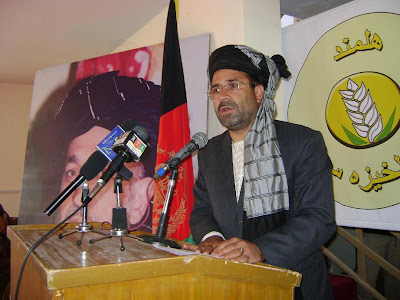
Once the national elections are behind them, local Afghan leaders will step up efforts to reconcile with midlevel Taliban in the extremists' southern Helmand province stronghold, a key provincial official said Monday.
Helmand Gov. Gullab Mangal called reconciliation efforts the next top project.
There is little hope of even an attempt by U.S. forces for a cease-fire agreement with Taliban leaders. But officials are looking to turn what some call the "ten-dollar Taliban" — locals who are hired to fight for the militants.
"We have seen that they also are interested — that the middle-level Taliban are also interested in reconciliation," Mangal told U.S. Gen. James Conway, commandant of the Marine Corps, in a meeting Monday in Mangal's Lashkar Gah office.
Mangal said he was starting to work on a reconciliation strategy.
"The presidential election was the top project. We're working real hard on that," Mangal said. "After this, we will try our best, we will work on this project, reconciliation."
Conway was in Afghanistan to meet with U.S. troops and discuss with other military officials whether he will need to send in more Marines.
Mangal and Conway agreed that Afghan security forces are needed in the south, a decision that Mangal said would be made in Kabul. They also discussed making sure civilians are evacuated from villages before any future operations Marines might launch. Enemy extremists often use civilians as shields, or otherwise hold them hostage in a deliberate attempt to blame deaths on U.S. and NATO forces.
Later, at a dust-coated dirt castle in Khan Neshin, a local Afghan leader told Conway that troops already have cleared Taliban extremists from his district. Now, villagers want to know how long the Marines will remain to keep the militants away, said Massoud Achmad Rassouli Balouchi, the Khan Neshin district governor.
Conway said his troops would remain as long as they are needed.
"You tell us what the timing is," Conway told Balouchi in a cramped room in the dirt-castle compound. "Until then you tell us what needs to happen."
How long, and how many, U.S. forces will remain in Afghanistan also is very much on the minds of troops and civilian government-building teams across Helmand. Conway has said he expects to be asked to send more troops, although he does not want the total number of Marines in Afghanistan to exceed 18,000. There are just over 11,000 Marines currently in the country, meaning the Pentagon could order deploying an additional regiment of up about 7,000 Marines.
Civilian officials from the U.S. State Department and the British government also are calling for more U.S. troops to stabilize communities. Officials privately say it's not clear they can assure the Afghan people they are safe to set up local government system without more troops.
Last month, two hours after landing at their base Khan Neshin, Marines whose vehicle had broken down came under rocket shelling and gunfire. They were under fire for the next three days, said Lance Cpl. Thomas Herr.
"They were right around the corner," said Herr, 20, of Umatilla, Fla., describing mortar attacks and small-arms fire from extremists.
"Lately, since the election, we've mostly been IDF'ed," he said, referring to indirect fire, usually mortar attacks.
He did not know whether the troops' returned fire was successful.
Surveillance planes "keep saying they're dragging off bodies, but we don't know, and we haven't found any," Herr said.
"They're pretty good at covering their tracks," said another Marine.




No comments:
Post a Comment